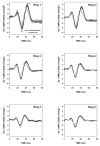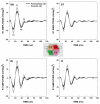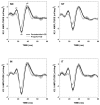The effect of pentobarbital sodium and propofol anesthesia on multifocal electroretinograms in rhesus macaques
- PMID: 22200766
- PMCID: PMC3295608
- DOI: 10.1007/s10633-011-9306-x
The effect of pentobarbital sodium and propofol anesthesia on multifocal electroretinograms in rhesus macaques
Abstract
We compared the suitability of pentobarbital sodium (PB) and propofol (PF) anesthetics for multifocal electroretinograms (mfERGs) in rhesus macaques. mfERGs were collected from 4 ocularly normal rhesus macaques. All animals were pre-anesthetized with intramuscular ketamine (10-15 mg/kg). Intravenous PB induction/maintenance levels were 15 mg/kg/2-10 mg/kg and for PF, 2-5 mg/kg/6-24 mg/kg/h. There were 3 testing sessions with PB anesthesia and 5-7 testing sessions with PF anesthesia. All PB sessions were carried out before PF. First-order (K1) and second-order (first slice) kernels (K2.1) response density amplitude (RDA), implicit time (IT), and root mean square signal-to-noise ratios (RMS SNR) of the low-frequency (LFC) and high-frequency (HFC) components were evaluated. The use of PF or PB anesthesia resulted in robust, replicable mfERGs in rhesus macaques; however, RMS SNR of K1 LFC in ring and quadrant analyses was significantly larger for PF than for PB. Additionally, K1 RDA under PF was significantly larger than under PB for N1, P1, and P2 components (ring and quadrant) and for N2 (quadrant). PF IT was significantly prolonged (<1 ms) relative to PB IT for N1, P1 (ring), and N1 (quadrant), while PB IT was significantly prolonged (0.8-4.2 ms) relative to PF IT for N2 and P2 (ring and quadrant). K1 HFC and K2.1 LFC did not differ significantly between PB and PF in the ring or quadrant analyses. The response differences found with PB and PF anesthesia likely arise from variable relative effects of the anesthetics on retinal γ-aminobutyric acid (GABA(A)) receptors, and in part, on glycine and on glutamate receptors. Given the advantages of a stable anesthetic plane with continuous intravenous infusion and a smoother, more rapid recovery, PF is an appealing alternative for mfERG testing in rhesus macaques.
Figures








Similar articles
-
Interspecies and gender differences in multifocal electroretinograms of cynomolgus and rhesus macaques.Doc Ophthalmol. 2004 Jul;109(1):73-86. doi: 10.1007/s10633-004-2630-7. Doc Ophthalmol. 2004. PMID: 15675202
-
Effects of reference electrode location on monopolar-derived multifocal electroretinograms in cynomolgus monkeys.Doc Ophthalmol. 2005 Sep;111(2):113-25. doi: 10.1007/s10633-005-4781-6. Epub 2006 Mar 2. Doc Ophthalmol. 2005. PMID: 16514493
-
Multifocal visual evoked potentials in the anesthetized non-human primate.Curr Eye Res. 2006 Oct;31(10):885-93. doi: 10.1080/02713680600899648. Curr Eye Res. 2006. PMID: 17050280
-
Propofol: a review of its role in pediatric anesthesia and sedation.CNS Drugs. 2015 Jul;29(7):543-63. doi: 10.1007/s40263-015-0259-6. CNS Drugs. 2015. PMID: 26290263 Free PMC article. Review.
-
Actions of Propofol on Neurons in the Cerebral Cortex.J Nippon Med Sch. 2017;84(4):165-169. doi: 10.1272/jnms.84.165. J Nippon Med Sch. 2017. PMID: 28978896 Review.
Cited by
-
Therapeutic Action of Honokiol on Postoperative Ileus via Downregulation of iNOS Gene Expression.Inflammation. 2017 Aug;40(4):1331-1341. doi: 10.1007/s10753-017-0576-7. Inflammation. 2017. PMID: 28493080
-
Repeated measurements of ERGs and VEPs using chloral hydrate sedation and propofol anesthesia in young children.Doc Ophthalmol. 2021 Oct;143(2):141-153. doi: 10.1007/s10633-021-09830-2. Epub 2021 Mar 29. Doc Ophthalmol. 2021. PMID: 33778913
-
Comparison of retinal parameters between rhesus and cynomolgus macaques.Exp Anim. 2024 Feb 14;73(1):20-28. doi: 10.1538/expanim.22-0022. Epub 2023 Jul 18. Exp Anim. 2024. PMID: 37460311 Free PMC article.
-
Regional choroidal blood flow and multifocal electroretinography in experimental glaucoma in rhesus macaques.Invest Ophthalmol Vis Sci. 2014 Nov 4;55(12):7786-98. doi: 10.1167/iovs.14-14527. Invest Ophthalmol Vis Sci. 2014. PMID: 25370515 Free PMC article.
-
Time-Dependent Decline in Multifocal Electroretinogram Requires Faster Recording Procedures in Anesthetized Pigs.Transl Vis Sci Technol. 2017 Mar 21;6(2):6. doi: 10.1167/tvst.6.2.6. eCollection 2017 Mar. Transl Vis Sci Technol. 2017. PMID: 28377845 Free PMC article.
References
-
- Hood DC, Frishman LJ, Viswanathan S, Robson JG, Ahmed J. Evidence for a ganglion cell contribution to the primate electroretinogram (ERG): effects of TTX on the multifocal ERG in macaque. Vis Neurosci. 1999;16:411–416. - PubMed
-
- Frishman LJ, Saszik S, Harwerth RS, Viswanathan S, Li Y, Smith EL, 3rd, Robson JG, Barnes G. Effects of experimental glaucoma in macaques on the multifocal ERG Multifocal ERG in laser-induced glaucoma. Doc Ophthalmol. 2000;100:231–251. - PubMed
-
- Hood DC, Frishman LJ, Saszik S, Viswanathan S. Retinal origins of the primate multifocal ERG: implications for the human response. Invest Ophthalmol Vis Sci. 2002;43:1673–1685. - PubMed
-
- Rangaswamy NV, Hood DC, Frishman LJ. Regional variations in local contributions to the primate photopic flash ERG: revealed using the slow-sequence mfERG. Invest Ophthalmol Vis Sci. 2003;44:3233–3247. - PubMed
-
- Hare WA, Ton H, Ruiz G, Feldmann B, Wijono M, WoldeMussie E. Characterization of retinal injury using ERG measures obtained with both conventional and multifocal methods in chronic ocular hypertensive primates. Invest Ophthalmol Vis Sci. 2001;42:127–136. - PubMed
Publication types
MeSH terms
Substances
Grants and funding
LinkOut - more resources
Full Text Sources
Medical

